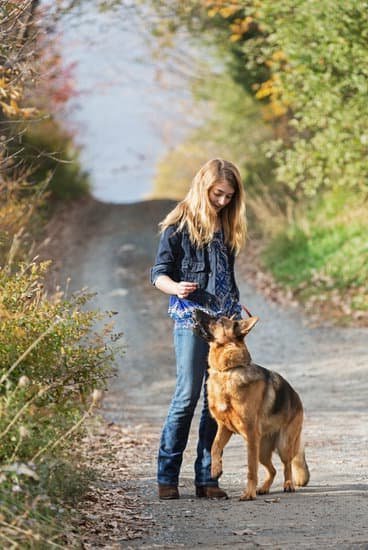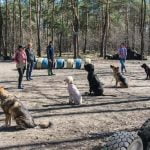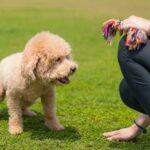Does your dog seem to have a penchant for chewing on everything in sight? If you’re wondering how to train dog not to chew on stuff, you’re in the right place. Understanding the root of this problem is the first step towards finding an effective solution. In this section, we will delve into the reasons why dogs exhibit chewing behavior, helping you identify the underlying causes behind this common issue.
It’s important to recognize that chewing is a natural and instinctive behavior for dogs. Whether it’s due to teething, boredom, anxiety, or simply exploring their environment, there are various reasons why dogs feel compelled to gnaw on objects around them. By understanding these motivations, you can take proactive steps to address the root of the problem and prevent destructive chewing habits from developing.
To successfully train your dog not to chew on stuff, it’s crucial to grasp the significance of identifying and addressing the underlying cause of their behavior. This section will provide valuable insights into the common reasons for chewing behavior, empowering you with knowledge that will form the foundation for effective training techniques in later sections.
Puppy Teething vs Destructive Chewing
Understanding the difference between puppy teething and destructive chewing is essential for addressing your dog’s chewing behavior. When puppies are teething, they often feel discomfort in their gums, leading them to chew on things to alleviate the pain. It’s a natural behavior that can be managed with appropriate chew toys and activities. However, destructive chewing goes beyond teething and involves the destruction of valuable items such as furniture, shoes, and household objects.
Tips for Managing Puppy Teething
During the teething phase, it’s crucial to provide your puppy with suitable chew toys and bones to redirect their chewing behavior. Frozen washcloths or specially designed teething rings can also help soothe their gums. Additionally, offering praise and attention when they chew on appropriate items reinforces positive behavior.
Impact of Improper Handling of Teething
Improper handling of a puppy’s teething phase can lead to future destructive chewing habits. If you do not provide suitable outlets for your puppy to relieve their discomfort during teething, they may develop a preference for inappropriate items to chew on later in life. Understanding this distinction is vital in effectively managing your dog’s chewing behavior throughout their development.
By addressing the specific needs of your dog during the teething phase and providing appropriate outlets for their chewing habits, you can set a foundation for preventing destructive chewing behaviors in the future. Understanding the underlying reasons for your dog’s chewing habits is crucial in implementing effective training techniques on how to train dog not to chew on stuff.
Creating a Safe and Stimulating Environment
One of the key factors in preventing dogs from chewing on inappropriate items is to create a safe and stimulating environment for them. This involves puppy-proofing the home by removing any hazardous objects or valuable items that could potentially be chewed on. It is also important to provide mental and physical stimulation for your dog to prevent boredom, which can often lead to destructive chewing behavior.
To create a safe environment, it is essential to identify potential hazards in the home such as electrical cords, small objects, and toxic plants. By removing these items or keeping them out of reach, you can minimize the risk of your dog chewing on something that could harm them. Additionally, providing proper mental and physical exercise through activities like puzzle toys, interactive feeders, and daily walks can help reduce boredom and prevent destructive chewing.
Another important aspect of creating a stimulating environment is to provide your dog with safe and appropriate chew toys. It is natural for dogs to chew as it helps with teething in puppies and provides mental stimulation in adult dogs. By offering a variety of durable chew toys that are designed specifically for dogs, you can redirect their chewing behavior onto items that are safe and suitable for them.
In summary, creating a safe and stimulating environment plays a crucial role in preventing dogs from chewing on stuff they shouldn’t. By puppy-proofing the home, providing mental and physical stimulation, and offering safe chew toys, dog owners can effectively address this common behavioral issue.
| Safe Environment Tips | Stimulating Activities |
|---|---|
| Identify potential hazards | Puzzle toys |
| Remove hazardous objects | Interactive feeders |
| Provide safe chew toys | Daily walks |
Positive Reinforcement Training
Training a dog not to chew on stuff can be a challenging but necessary process for many dog owners. Positive reinforcement training is an effective and humane approach to discourage destructive chewing behavior in dogs. By using rewards and positive feedback, you can teach your dog what is acceptable to chew on and what is not. Here are some key techniques for implementing positive reinforcement training to address chewing:
1. Introduce and consistently use high-value treats: Use treats that your dog really loves, such as small pieces of cooked chicken or cheese, to reward good behavior when it comes to chewing. Whenever you catch your dog chewing on an appropriate item, immediately praise them and give them a treat.
2. Practice “leave it” and “drop it” commands: Teaching your dog the cues “leave it” and “drop it” can be incredibly helpful in redirecting their attention away from inappropriate items. This can be especially useful when they pick up something they shouldn’t have in their mouth.
3. Use verbal cues and positive reinforcement: When you notice your dog chewing on an acceptable toy or bone, use verbal cues such as “good boy/girl” or “yes.” to reinforce the behavior. Dogs respond well to positive verbal feedback, so make sure to consistently provide encouragement when they’re doing the right thing.
It’s important to remember that positive reinforcement training requires patience and consistency. Instead of punishing your dog for chewing on things they shouldn’t, focus on rewarding good behavior and providing them with appropriate alternatives. Over time, your dog will learn what is expected of them and develop better chewing habits.
Redirection Techniques
When it comes to training a dog not to chew on stuff, redirection techniques can be an effective strategy to prevent destructive chewing. By redirecting the dog’s focus onto more appropriate behaviors and activities, you can help minimize unwanted chewing behavior. Here are some actionable redirection techniques that you can implement:
- Provide appropriate chew toys: Offer a variety of safe and durable chew toys for your dog to redirect their chewing behavior. Interactive toys, puzzle feeders, and dental chews can provide mental and physical stimulation while satisfying your dog’s natural urge to chew.
- Engage in interactive play: Spend time engaging in interactive play with your dog to redirect their energy and attention. Playing games such as fetch, tug-of-war, or hide-and-seek can help channel their chewing instincts into positive outlets.
- Practice obedience training: Use basic obedience commands such as “sit,” “stay,” and “leave it” to redirect your dog’s focus away from inappropriate chewing. Training sessions provide mental stimulation and reinforce positive behaviors, ultimately helping to discourage destructive chewing.
It is important to note that consistent supervision and reinforcement of redirection efforts are crucial for success. By actively redirecting your dog’s attention towards more suitable activities, you can effectively steer them away from destructive chewing habits.
Overall, implementing redirection techniques as part of a comprehensive training approach can contribute significantly to curbing unwanted chewing behavior in dogs.
Avoiding Punishment and Negative Reinforcement
When it comes to addressing a dog’s chewing behavior, it is crucial to avoid punishment and negative reinforcement. While it may be tempting to scold or punish a dog for chewing on household items, these methods can actually exacerbate the problem rather than resolve it. Dogs do not understand punishment in the same way humans do, and negative reinforcement can lead to fear, anxiety, and even aggressive behavior.
Instead of using punishment as a method of discouraging chewing, positive training methods should be prioritized. Positive reinforcement involves rewarding desired behaviors, such as choosing appropriate chew toys over household items. This approach helps the dog associate good behavior with positive outcomes, reinforcing their understanding of what is acceptable.
One effective technique for avoiding punishment and negative reinforcement is redirection. This involves redirecting the dog’s focus from inappropriate chewing to an alternative behavior that is more desirable. For example, if a dog starts chewing on furniture, redirect their attention to a chew toy or engage them in a stimulating activity.
By adopting positive reinforcement and redirection techniques instead of punishment and negative reinforcement, dog owners can create a supportive and encouraging training environment that promotes healthy chewing habits.
| Training Methods | Effectiveness |
|---|---|
| Positive Reinforcement | Highly Effective |
| Redirection | Effective when consistently used |
Seeking Professional Help
In some cases, despite the dog owner’s best efforts, a dog’s chewing behavior may persist or even worsen. When destructive chewing becomes severe and persistent, it may be necessary to seek professional help from a dog trainer or behaviorist. These experts are equipped with the knowledge and experience to assess the underlying reasons for the chewing behavior and develop a tailored training plan to address it.
When considering professional assistance, it is essential to look for a reputable and certified dog trainer or behaviorist who uses positive reinforcement-based methods. This approach focuses on rewarding desired behaviors rather than punishing undesirable ones, creating a more effective and humane training experience for the dog.
It is important to recognize that early intervention is key when dealing with severe chewing behavior. The longer the problem persists, the more ingrained the habit may become, making it harder to break. Seeking professional help at the first signs of persistent destructive chewing can greatly improve the chances of successfully modifying the dog’s behavior.
Ultimately, by seeking professional help, dog owners can gain valuable insights into how to train their dogs not to chew on stuff effectively. Additionally, these experts can provide ongoing support and guidance as they tailor training techniques and strategies based on the specific needs of both the dog and its owner.
Monitoring Progress and Adjusting Strategies
In conclusion, training a dog not to chew on stuff requires patience, consistency, and an understanding of the underlying reasons for this behavior. By first understanding the root of the problem, dog owners can identify the common reasons for chewing behavior and address them effectively.
It is crucial to differentiate between normal puppy teething and destructive chewing, as improper handling of teething can impact future chewing habits. Creating a safe and stimulating environment through puppy-proofing the home and providing mental and physical stimulation can also prevent boredom and curb destructive chewing.
Positive reinforcement training techniques, such as redirecting the dog’s focus to appropriate chew toys and activities, are effective in discouraging destructive chewing. It is important to avoid punishment and negative reinforcement, as these approaches can have detrimental effects on the dog-human relationship. Seeking professional help may be necessary for severe cases of chewing behavior, emphasizing the importance of early intervention and proactive management.
Finally, monitoring progress and adjusting strategies are essential in addressing this behavioral issue. Regular assessment of the dog’s chewing behavior allows for adaptation of training techniques based on progress and setbacks. Through ongoing reinforcement of good chewing habits, dog owners can successfully train their dogs not to chew on unwanted items. Overall, addressing this common behavioral issue requires dedication, understanding, and a proactive approach to training.
Frequently Asked Questions
How Do I Train My Dog Not to Chew on Everything?
Training a dog not to chew on everything requires patience, consistency, and positive reinforcement. Providing appropriate chew toys, using deterrent sprays, and redirecting their behavior to the toys can help discourage destructive chewing.
How Can I Stop My Dog Chewing Things When Left Alone?
To prevent a dog from chewing things when left alone, it’s important to ensure they have enough physical and mental stimulation. Providing interactive toys, exercise before leaving them alone, and crate training can help curb destructive chewing behavior.
How Do I Get My Dog to Stop Destroying Everything?
Getting a dog to stop destroying everything involves understanding the root cause of their behavior. It may be due to boredom, anxiety, or lack of proper training. Addressing these issues through exercise, mental stimulation, and positive reinforcement training can help modify their behavior.

Welcome to the blog! I am a professional dog trainer and have been working with dogs for many years. In this blog, I will be discussing various topics related to dog training, including tips, tricks, and advice. I hope you find this information helpful and informative. Thanks for reading!





